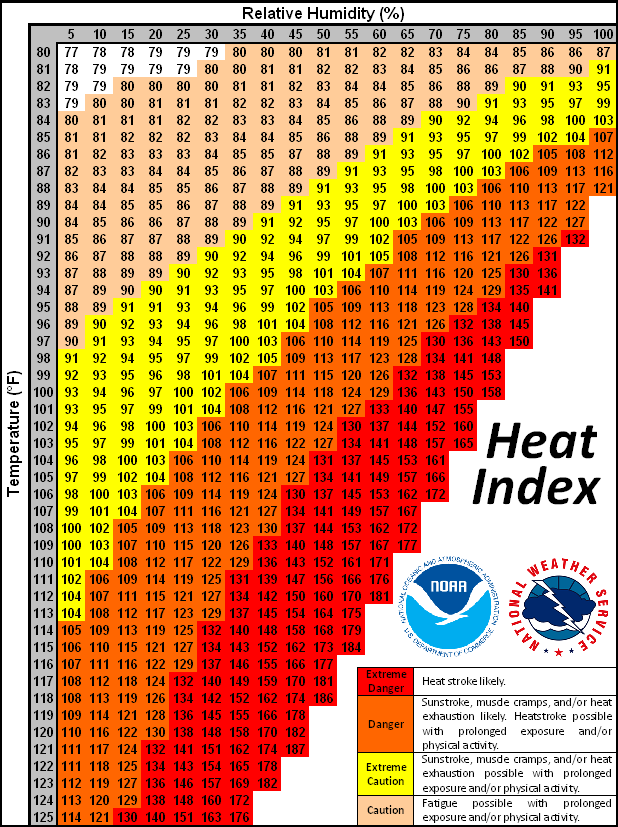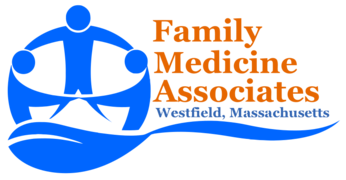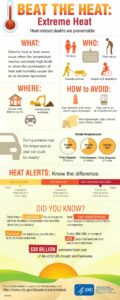
What to look for |
What to do |
|
|---|---|---|
Heatstroke |
|
|
Heat Exhaustion |
|
Get medical help right away if:
|
Heat Cramps |
|
Get medical help right away if:
|
Sunburn |
|
|
Body aches |
Sometimes (usually mild) | Common (can be severe) |
Heat Rash |
Red clusters of small blisters that look like pimples on the skin (usually on the neck, chest, groin, or in elbow creases) |
|
Causes of Heat Exhaustion and Heatstroke
Simply put, your body is overheating faster than it can cool itself. Sweating is a means of evaporating water on the surface of the skin to cool the body, and is the body’s first line of defense against overheating. In hot, humid weather, sweating is not as efficient in cooling the body due to the high level of moisture in the air. As your ability to cool down through sweating becomes less efficient, your body temperature rises and you may experience the symptoms of heat exhaustion coming on.
Just being outside in the sun on hot days can put you at risk, depending on your health, and physical exertion (sports, exercise) can quickly lead to overheating, heat exhaustion and heatstroke. You’ve probably heard of The Heat Index.3)

During the summer months, your local weather forecast on TV is always mentioning Heat Index. What is it? Heat Index is temperature based on a formula which calculates the actual temperate, factoring in humidity. It’s NOT the the same as the actual measured temperature. Heat Index is a measurement of discomfort felt as a result of combining both of the above factors. Example: The outside temperature is 90°F degrees with relative humidity of 65%. This is not unheard of in New England! The Heat Index based on the above would, according to the National Weather Service, be: 103°F . In other words, it would feel like 103 degrees!4)
When to seek medical attention?
If a person is displaying the typical heat-related symptoms, try to take their temperature immediately.
Any temperature of 104°F or higher indicates heatstroke. Call 911.
Heatstroke is very severe medical emergency. Seek medical help or take the victim to the nearest Hospital Emergency Room without delay!
How can heat exhaustion and heatstroke be prevented or avoided?
There are many things you can do to prevent heat-related illnesses. The most basic is awareness of the problem. Keep in mind that infants, children, and the elderly are more vulnerable to overheating. Those who are ill, obese, or those with heart disease are also at greater risk than the general population for heat exhaustion and heat stroke. Obviously, people working outside or without air conditioning also are at elevated risk.
If possible, when the heat index is very high, just don’t go outside. It’s much safer to stay in air-conditioned places. If you have to work or go outside, here are some tips to do so safely:
- Wear lightweight, light-colored, loose-fitting clothing. Avoid synthetic fibers. Cotton and other summer-weight fabrics are best.
- Wear a hat!
- Use a sunscreen (SPF) of 15 or higher.
- Drink enough water throughout the day. Drink more than you normally do, even if you don’t feel thirsty. Dehydration and lack of salt and/or electrolytes can impair your body from efficiently cooling. Sports drinks which are high in electrolytes can help replenish the salts in your body that you lose through sweat. Dark-colored urine is a warning sign that you’re already dehydrated.
- Avoid caffeine. It’s a diuretic, which causes your body to excrete water and can lead to rapid dehydration in hot weather. Avoid alcohol as well.
- Plan your schedule around the weather. Avoid the hottest hours of the day.
Don’t stay in a car or leave kids or pets in a car without air condition on a hot day.
If you’re taking prescription medicine, be aware that certain drugs can interfere with your body’s ability to regulate heat and can put you at higher risk of heat exhaustion or heatstroke. Talk to your doctor or pharmacist if you are taking:
- Antibiotics
- Allergy medicines (antihistamines)
- Some medicines used to manage blood pressure, cholesterol, and heart disease (beta-blockers and vasoconstrictors)
- Some medicines that treat mental health problems (antidepressants and antipsychotics)
- Seizure medicines (anticonvulsants)
- Water pills (diuretics)
- Laxatives
- Some diet pills
- Prescription acne medicines
- Illegal drugs, such as cocaine (amphetamines)
Treatment: Act Fast!
Get out of the heat. Get out of the sun! Go to cool place, or at a minimum, seek shade.
- Lie down. Raise/Elevate your legs to improve blood circulation.
- Take off unnecessary clothing. Loosen your clothing.
- Cool your skin. Place cool towels or washcloths on your face and forehead. If possible take a cool shower or bath. The purpose is to get your body temperature down fast.
- Drink cool fluids, such as water or a sports drink. Sip, don’t drink too fast.
Heatstroke: Call 911 if:
- Symptoms don’t improve or the person still has a fever of 102°F after 30 minutes of initial treatment.
- The person goes into shock, faints, or has seizures.
- The person stops breathing. Begin CPR.
Recovery
When recovering from heat exhaustion or heatstroke, it’s important to avoid overheating again. Stay out of the sun and hot weather. You’ll probably experience an increased sensitivity to heat which may last for days or more than a week. Rest is very important. Consult with your doctor about your progress and when you should return to a normal routine.
5)
Feature Photo Credit: Kate Brady ,
https://creativecommons.org/licenses/by/2.0/
Sources and References
| ↩1 | (2017, July 4). Dog Days Retrieved July 31, 2017, from https://en.wikipedia.org/wiki/Dog_days |
|---|---|
| ↩2 | (2017, June 19). Warning Signs and Symptoms of Heat-Related Illness. Retrieved July 31, 2017, from https://www.cdc.gov/disasters/extremeheat/warning.html |
| ↩3 | (2016, July 8) What is the Heat Index and Why Is It Used Retrieved July 31, 2017 from https://weather.com/safety/heat/news/heat-index-feels-like-temperature-summer |
| ↩4 | ”What is the Heat Index and Why Is It Used? | The Weather Channel.” Accessed July 31, 2017. https://weather.com/safety/heat/news/heat-index-feels-like-temperature-summer |
| ↩5 | (2017, July 20) Infographic: Beat The Heat https://www.cdc.gov/phpr/infographics/beattheheat.htm |

